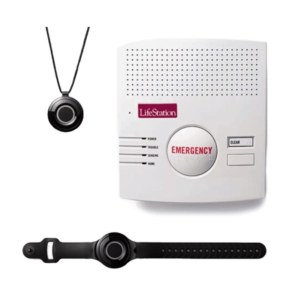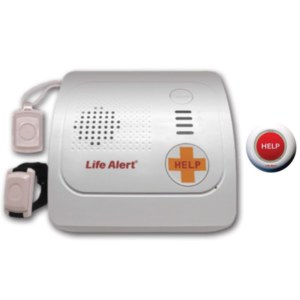LifeStation Vs. Life Alert Medical Alert Systems: Which Is Better?
AgingInPlace.org keeps our resources free by working as an affiliate partner with some companies mentioned on our site. These partnerships or the commission we may earn do not affect our opinions or evaluations of the products we mention. Our reviews are solely based on our research methodology and from input from our AgingInPlace.org Advisory Board. Learn more about our ad policies.
LifeStation Vs. Life Alert Medical Alert Sys...
Products carousel
LifeStation vs. Life Alert Comparison Overview
LifeStation and Life Alert are two trusted medical alert device companies that have been around for decades. In this review, we compare the plans each brand offers, the costs, pros and cons, and more, so you can choose the best medical emergency support system for you or your loved ones.
Comparing Life Alert vs. LifeStation Medical Alert Systems
Cost
“When choosing between companies, you should consider the cost and the services provided,” explained Melanie Musson, a Senior Care Expert with InsuranceProviders.com.
“While basic service is usually similar between companies, you need to decide if basic service is suitable for your situation or if you need an expanded system with GPS and fall detection. Then compare costs for the type of system you need.”
Whether you choose a home-only policy or one with GPS tracking for support when you leave your home, LifeStation’s plans are more affordable than Life Alert’s. Additionally, LifeStation has no contract and a 30-day money-back guarantee, while Life Alert has no trial period and a 3-year contract.
| LifeStation | Life Alert | |
|---|---|---|
Monthly Cost
|
|
|
| Shipping Fee | $10 | $0 |
| Activation Fee | $50 | $195–$198 |
| Equipment Charge | $0 | $0 |
| Fall Detection | $6–$12/month | Not available |
| Warranty | No warranty available | Included in monthly price |
| Spousal Coverage | $3.99 for an extra pendant (home plan) Full price (on-the-go plan) | $10/month |
| Risk-Free Trial | Yes: 30 days | No |
| Contract | No | 3 years |
Monthly Cost
| LifeStation |
| Life Alert |
|
|---|
| Shipping Fee | LifeStation | $10 | Life Alert | $0 |
|---|
| Activation Fee | LifeStation | $50 | Life Alert | $195–$198 |
|---|
| Equipment Charge | LifeStation | $0 | Life Alert | $0 |
|---|
| Fall Detection | LifeStation | $6–$12/month | Life Alert | Not available |
|---|
| Warranty | LifeStation | No warranty available | Life Alert | Included in monthly price |
|---|
| Spousal Coverage | LifeStation | $3.99 for an extra pendant (home plan) Full price (on-the-go plan) | Life Alert | $10/month |
|---|
| Risk-Free Trial | LifeStation | Yes: 30 days | Life Alert | No |
|---|
| Contract | LifeStation | No | Life Alert | 3 years |
|---|
Features
Life Alert offers the least frills of any medical alert company we’ve researched. You may choose between the in-home and on-the-go plans, with every product boasting a generous battery life. You’ll never need to charge your device, and there aren’t features like a caregiver app or fitness tracking. The result is an incredibly straightforward medical alert product.
LifeStation’s plans include everything that Life Alert’s policies do, with some additional options. For instance, you may choose a discreet and stylish smartwatch with LifeStation or stick with the standard help button that you wear as a necklace or on your wrist. Also, there’s a caregiver app with location tracking so your loved ones can see where you are. Plus, Uber Health can assist in arranging transportation to medical appointments.
| LifeStation | Life Alert | |
|---|---|---|
| Connection | Landline or cellular | Landline or cellular |
| Water Resistance | Yes | Yes |
| Battery Life | In-home unit: 32-hour backup In-home help button: Up to 4 years On-the-go help button: Up to 5 days Sidekick smartwatch: One day | In-home unit: 3-day backup In-home help button: Up to 10 years On-the-go help button: up to 10 years |
| Home Device Range | 500 feet | 800 feet |
| Caregiver App | Yes | No |
| Caregiver Location Monitoring | Yes | No |
| Fitness Tracking | Yes (Sidekick Smart only) | No |
| Uber Transportation | Yes | No |
| Connection | LifeStation | Landline or cellular | Life Alert | Landline or cellular |
|---|
| Water Resistance | LifeStation | Yes | Life Alert | Yes |
|---|
| Battery Life | LifeStation | In-home unit: 32-hour backup In-home help button: Up to 4 years On-the-go help button: Up to 5 days Sidekick smartwatch: One day | Life Alert | In-home unit: 3-day backup In-home help button: Up to 10 years On-the-go help button: up to 10 years |
|---|
| Home Device Range | LifeStation | 500 feet | Life Alert | 800 feet |
|---|
| Caregiver App | LifeStation | Yes | Life Alert | No |
|---|
| Caregiver Location Monitoring | LifeStation | Yes | Life Alert | No |
|---|
| Fitness Tracking | LifeStation | Yes (Sidekick Smart only) | Life Alert | No |
|---|
| Uber Transportation | LifeStation | Yes | Life Alert | No |
|---|
Fall Detection
Mary Winners, Gerontologist and Founder of About Senior Solutions, shared her top priority when selecting the best medical alert product: “For me, a call button is rather useless without the fall detection.”
She added, “For example, a past client purchased a system without fall detection. The client, a lovely woman of 86, was diligent in wearing her device. The daughter…arranged a standard support system without fall detection. Doris fell between her bed and end table; her daughter found her conscious and non-verbal, but several hours after the incident. Those precious hours kept her from getting the crucial medical treatment she needed, not to mention the fact that she was alone.”
Life Alert doesn’t offer automatic fall detection on any medical alert products. This means that if you want the added security that this feature provides, you’ll need to go with LifeStation. Only two of LifeStation’s plans offer this feature: the cellular-connection home plan for $44.95/month and the Sidekick GPS plan for $43.95/month. For other options, check out our article on the Medical Alert Systems With Fall Detection.
Extras
Neither LifeStation nor Life Alert offers many extras. Instead, both companies have simple plans that are easy to use and won’t add unexpected costs. Listed below are the optional features that you may pay extra for access to with each company.
| LifeStation | Life Alert | |
|---|---|---|
| Lockbox | $2.95/month | Not available |
| Wall Buttons | $2.95/month | Included in monthly price |
| Lockbox | LifeStation | $2.95/month | Life Alert | Not available |
|---|
| Wall Buttons | LifeStation | $2.95/month | Life Alert | Included in monthly price |
|---|
LifeStation Overview

Who Is LifeStation For?
Thanks to LifeStation’s product line and pricing structure, it suits most seniors looking for a medical alert device. It’s this combination that earned LifeStation a spot on our compilation of the Best Medical Alert Systems.
LifeStation’s in-home and on-the-go plans have an average price compared to other leading brands. Additionally, LifeStation provides some of the features and offers that we recommend for seniors. These include:
- A 30-day trial with a money-back guarantee
- No long-term contracts
- Automatic fall detection
- A free caregiver app
- Location monitoring, so your loved ones can see where you are
What Are The Costs Of LifeStation?
| In-Home | Sidekick (On-the-Go) | Sidekick Smart (On-the-Go Smartwatch) | |
|---|---|---|---|
| Monthly Price | $22.95 (landline) $32.95 (cellular) | $37.95 | $42.95 |
| Shipping Fee | $10 | $10 | $10 |
| Fall Detection | $12/month (cellular only) | $6/month | Not available |
| Warranty | No warranty available | No warranty available | No warranty available |
| Spousal Coverage | $3.99 for an extra pendant | Full price | Full price |
| Monthly Price | In-Home | $22.95 (landline) $32.95 (cellular) | Sidekick (On-the-Go) | $37.95 | Sidekick Smart (On-the-Go Smartwatch) | $42.95 |
|---|
| Shipping Fee | In-Home | $10 | Sidekick (On-the-Go) | $10 | Sidekick Smart (On-the-Go Smartwatch) | $10 |
|---|
| Fall Detection | In-Home | $12/month (cellular only) | Sidekick (On-the-Go) | $6/month | Sidekick Smart (On-the-Go Smartwatch) | Not available |
|---|
| Warranty | In-Home | No warranty available | Sidekick (On-the-Go) | No warranty available | Sidekick Smart (On-the-Go Smartwatch) | No warranty available |
|---|
| Spousal Coverage | In-Home | $3.99 for an extra pendant | Sidekick (On-the-Go) | Full price | Sidekick Smart (On-the-Go Smartwatch) | Full price |
|---|
Pros And Cons Of LifeStation
Pros
-
Affordable in-home and on-the-go policies
-
Optional automatic fall detection
-
Free caregiver app with location monitoring
-
A pedometer tracks steps when wearing the Sidekick smartwatch
-
Singular on-the-go device when you opt for fall detection with the Sidekick plan
-
30-day money-back guarantee
-
No contracts
-
Good third-party customer reviews (3.76/5-stars on the Better Business Bureau)
Cons
-
No spousal discount for the Sidekick and Sidekick Smart on-the-go plans
-
Fall detection isn’t available on the most affordable (landline) policy
-
The short 500-foot home range is not a great fit for larger properties
-
One-day battery life with the smartwatch
-
Must purchase LifeStation Protection Plan at $6/month for loss or damage protection
-
Inconsistent information given by customer service representatives during phone calls
Different Plans And Models Of LifeStation
Cost: $22.95/month (landline) or $32.95/month (cellular) + $10 shipping fee
LifeStation’s in-home medical alert system starts at an affordable $22.95/month when you connect to your landline but goes up to $32.95/month when you choose a cellular connection. With both policies, you receive the in-home base station and a wearable help button that you wear around either your neck or wrist. The help button is small, weighing just half an ounce. The battery won’t need changing and should last up to four years.
When you press the help button, your home unit connects to LifeStation’s emergency monitoring center, which is based in the United States. You communicate through this unit, not through the help button itself. You may add a wall button with two-way communication to either of the home plans for $2.95/month, which is a good idea if you have a multi-level home or if you’d like extra security in the bath or shower.
LifeStation offers automatic fall detection, but only with the cellular option. With fall detection, LifeStation’s emergency response team is notified in the case of a fall, even when you can’t press the help button.
Cost: $37.95/month + $10 shipping fee
The Sidekick plan includes a lightweight (1.4 ounces) help button that you carry with you. A microphone and speaker are built into the Sidekick, so you won’t need your phone or any other device for protection. It has a rechargeable battery that needs charging every five days.
If you choose to add automatic fall detection to your Sidekick plan, you don’t need an additional pendant or help button. The Sidekick has internal fall detection technology, but you must wear it around your neck for it to accurately detect falls.
Cost: $42.95/month + $10 shipping fee
The Sidekick Smart is an attractive smartwatch. You press and hold the screen to alert LifeStation if you need help, and the built-in GPS tells the trained representative where you are.
The smartwatch is an excellent choice if you want medical alert protection, but you’d rather not wear an obvious device. A unique perk with the Sidekick Smart is its built-in fitness tracking that counts your steps.
Unfortunately, fall detection isn’t available with the smartwatch. Additionally, the battery doesn’t more than a day, so you’ll need to charge it nightly.
See our full LifeStation Review.
Life Alert Overview

Who Is Life Alert For?
Life Alert is a medical alert provider for seniors who desire simplicity and are comfortable paying a higher price for it. What makes Life Alert so easy to use is the unparalleled battery life for all of its products.
The home plan’s help button lasts up to five years, while the GPS button and wall help buttons last up to 10 years. These devices alert the in-home unit when the battery is low, and Life Alert automatically sends a replacement. In comparison, many brands use rechargeable batteries in the help buttons, requiring you to charge them anywhere from nightly to every few nights. For many older adults, regular battery charging isn’t feasible, leaving them unprotected.
Another aspect that simplifies Life Alert is that it offers few features. There’s no smartphone app, activity tracking, or anything else that may be hard for a user to understand. Life Alert doesn’t even offer automatic fall detection, which most companies provide.
The Life Alert representative we spoke with explained that the company doesn’t use fall detection technology because it’s not 100% reliable. This lack of reliability is actually a downside of fall detection that’s often discussed in customer reviews and supported by fall detection research.
What Are The Costs Of Life Alert?
| In-Home Only | In-Home + GPS or Wall Button | In-Home + GPS + Wall Button | |
|---|---|---|---|
| Monthly Price | $49.95 | $69.95 | $89.95 |
| Activation Fee | $195 | $197 | $198 |
| Spousal Coverage | $10/month | $10/month | $10/month |
| Monthly Price | In-Home Only | $49.95 | In-Home + GPS or Wall Button | $69.95 | In-Home + GPS + Wall Button | $89.95 |
|---|
| Activation Fee | In-Home Only | $195 | In-Home + GPS or Wall Button | $197 | In-Home + GPS + Wall Button | $198 |
|---|
| Spousal Coverage | In-Home Only | $10/month | In-Home + GPS or Wall Button | $10/month | In-Home + GPS + Wall Button | $10/month |
|---|
Pros And Cons Of Life Alert
Pros
-
Long battery life and no need to recharge batteries
-
Few features mean straightforward pricing
-
All-in-one and on-the-go help button with two-way communication
-
Waterproof wall button for bathroom has two-way communication
-
Good customer reviews: 3.6/5-stars on Better Business Bureau from 188 customer reviews
-
An 800-foot home unit range is sufficient for most houses
-
No warranty is needed; the cost to maintain and replace equipment is included in the price
-
More affordable than most plans to add a spouse to on-the-go plans
Cons
-
High price point for every plan
-
No automatic fall detection option
-
No on-the-go only policy; must bundle with home coverage
-
No risk-free trial period
-
3-year contract
-
No caregiver app with location monitoring
-
No unique features like medication or activity monitoring
-
Expensive to add a spouse to the in-home system
Cost: $49.95/month + $195 activation fee
Life Alert’s base plan is for home-only coverage. With this plan, you receive a primary home base unit and a help button. The base unit has the speaker and microphone that you use to communicate with Life Alert’s emergency assistance reps.
The help button weighs around half an ounce and is waterproof, so you can safely use it in your bathroom. The button comes with a bracelet and lanyard, allowing you to wear it around your wrist or neck. We love the Life Alert help button because it has a battery life of up to five years, which makes using it easier than a rechargeable device.
Cost: $69.95/month + $197 activation fee
The next step up from the home-only plan incorporates either GPS monitoring or a waterproof wall button in addition to the home devices outlined above.
The GPS help button gives you security when you leave your home. It’s much bigger than the home help button, weighing around four ounces. It has built-in two-way communication, so you only need to be wearing the GPS device on you for coverage. What sets this on-the-go monitor apart from its competitors is a 10-year battery life. Most on-the-go devices need recharging every few days, if not sooner.
Instead of the wireless on-the-go protection, you can choose a waterproof wall button. Most users place this button in their primary bathroom. The wall button has the microphone and speaker built into it, so you won’t need to be near your primary home unit to speak with Life Alert’s trained response team. Life Alert’s waterproof wall button also has a 10-year battery life.
Cost: $89.95/month + $198 activation fee
Life Alert’s most extensive plan incorporates the home base unit and help button, GPS on-the-go device, and waterproof wall button. While we like how well this plan covers seniors both in and out of the home, its nearly $90/month fee is too high for many people.
See our full Life Alert Review.
Similarities Between LifeStation vs. Life Alert
LifeStation and Life Alert are medical alert system companies that both offer home-only and on-the-go devices. The in-home units may connect to either your landline or a cellular network. Additionally, you can opt for additional wall buttons for added security in the bathroom. These home plans both come standard with a pendant with a multi-year battery life, so you don’t need to worry about charging them.
Main Differences
While both Life Alert and LifeStation offer personal emergency response systems for in-home and on-the-go coverage, there’s a lot that differentiates these brands. Some of these differing factors include:
- Only LifeStation’s medical alert system offers automatic fall detection.
- Life Alert’s help buttons have longer battery lives, requiring less effort on the customer side.
- LifeStation is more affordable than Life Alert.
- Life Alert’s home base unit has a longer range (800-foot vs. 500-foot).
- Only LifeStation has a Caregiver app with a location monitoring feature.
- LifeStation’s plans are monthly, quarterly, or annually, while Life Alert’s plans require a 3-year contract.
- LifeStation offers a 30-day risk-free trial, while Life Alert provides no money-back guarantee.
Key Takeaways
- LifeStation is more affordable than Life Alert.
- Life Alert’s longer battery life, especially on its GPS devices, requires less effort by the customer.
- LifeStation has more perks, including a Caregiver app, location monitoring, fitness tracking, a lockbox and Uber transportation assistance.
- Both companies have good customer reviews on third-party sites.
- Only LifeStation offers automatic fall detection.
What Customers Are Saying About Life Alert and LifeStation

LifeStation
“We have had this system for my mother for three years now and have been very satisfied. We have had to use it several times and they are very prompt and professional. On one occasion, I was on the phone with my mom and I told her to push the button. On another occasion, I was at her home and I pushed the button myself to get emergency services to her home. We also test the system periodically to make sure that it is working properly and to remind my mother, who is 92, that she has this service.”
Nancy L. 5/5-star review on the Better Business Bureau.
“Hypersensitive, oversized button causes constant emergency calls to the police, fire department, etc. This is only since their new very large, very sensitive button that is not suitable for any active person. They are good at responding but their supervisors refuse to help finding a smaller, less touchy emergency button.”
Stephanie D. 2/5-star review on the Better Business Bureau
Life Alert
“I have fallen 15 times in the last two and a half years. I’ve forgotten how many times I’ve called for assistance from you wonderful people. You’ve been truly angels for me.”
Isabelle S. 5/5-star review on the Better Business Bureau
“The sales person is very good and tells you that if your mother can no longer use the service because she dies or is incapacitated that the contract ends. But when that happens and you call Life Alert they put you through three switchboards and then tell you that they need a letter from a doctor! Outrageous. As if things aren’t hard enough caring for an elderly family member with dementia who can no longer live independently!”
Amy C. 3/5-star review on the Better Business Bureau.
Bottom Line
Life Alert creates some of the easiest medical alert devices to use. If you prefer not to have to charge batteries or manage your account through an online system, Life Alert may be the best brand for you. With batteries that last between three and 10 years, there’s not much that you need to do to keep the products working. And Life Alert doesn’t offer extras like a smartphone app or activity tracking, keeping things simple.
While the straightforward design of Life Alert is an excellent fit for some seniors, it has one major drawback: price. LifeStation’s prices are about half that of Life Alert’s, making LifeStation a better fit for people who desire a plan with an affordable price. Additionally, LifeStation provides a risk-free trial and no contract, compared to Life Alert’s 3-year contract and no trial period.
Another big difference between these brands is fall detection. Only LifeStation offers automatic fall detection, a feature that many experts we’ve spoken with agree is one of the most important features of a medical alert service for seniors. LifeStation also provides more features, like a Caregiver app that allows you to see where your loved one is when they’re wearing the on-the-go help button.
Why You Can Trust Our Expert Review
Our experts independently research and recommend products we believe provide value in the lives of our readers. We’ve collectively spent more than 1,700 hours conducting in-depth research on medical alert systems. To make our picks, here’s we:
- Engaged in ongoing independent research
- Consulted with geriatricians and adult caregivers
- Mystery shopped the brands
- Surveyed medical alert system users
- Tested various medical alert systems
- Interviewed experts in the field
- Read hundreds of verified customer reviews from trusted third parties, such as Better Business Bureau and Consumer Reports
How We Reviewed LifeStation and Life Alert Medical Alert Systems
We reviewed the LifeStation and Life Alert Medical Alert Systems based on the following criteria:
- Price of installation and monthly service
- Warranties, contracts, and (whether it has any) hidden fees
- Reliability of monitoring center
- Comfort and wearability of mobile devices
- In-home range of equipment
- Water resistance of wearable devices
- Battery life and recharging requirements
- Ease of installation and use
- Expert opinion
- Customer service accessibility and performance
- Customer satisfaction reviews
- Company reputation
- Special features, such as automatic fall detection, smartphone apps for family members, and location tracking
Our Comparisons of Medical Alert System
- Life Alert vs Medical Guardian
- Medical Alert vs Medical Guardian
- Lively vs Medical Alert
- Life Alert vs Medical Alert
- Medical Guardian vs Bay Alarm Medical
Other Medical Alert Systems That We Have Reviewed
- Medical Guardian Review
- MobileHelp Review
- Bay Alarm Medical Review
- Aloe Care Health Review
- LifeFone Review
- Life Alert Review
- GreatCall Lively Mobile Review
- Medical Alert Review
- GetSafe Review
- Philips Lifeline Review
- Rescue Alert Review
- ADT Medical Alert Review
- Alert1 Review
- UnaliWear Review
- MobileHelp Smart Watch Review
- Apple Watch Medical Alert Review
WRITTEN BY
Nicole is a freelance writer with a passion for wellness, nutrition, and healthy aging. Before entering the writing field, Nicole received her undergraduate degree in Organismal Biology from Scripps College and spent time as a nutrition coach. For the past seven years, Nicole has been a health writer for various wellness experts and publications, including Everyday Health, Health, and fitness icon Thomas Delauer. Much of Nicole’s research and writing work concentrates on healthy aging and sleep health. She uses her experience in biology and research skills to bring Aging In Place readers articles that improve health, wellness, and daily life.
View AuthorMEDICALLY REVIEWED BY
Jenny is an Adult-Gerontology Primary Care Nurse Practitioner in NYC with a passion for working with aging adults and their family members. Prior to her clinical training at Vanderbilt School of Nursing, she worked in business and medical research at Harvard Business School and Massachusetts General Hospital. As a Caregiving Coach at Givers, Jenny helps family members manage the financial, emotional, and educational stresses of caring for their loved ones who are aging in place.
View ReviewerDo you want to cite this page? Use our ready-made cite template.





